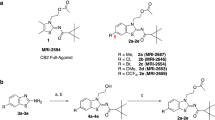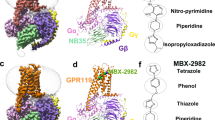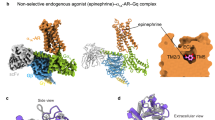Abstract.
The high-resolution crystal structure of an engineered human β2-adrenergic receptor has recently been resolved, suggesting a molecular mechanism by which cholesterol may mediate receptor dimerization. Here, we present a critical examination of new structural and functional insights derived from unprecedented preliminary homology modeling of cannabinoid receptors, obtained using the crystal structure of β2-adrenergic receptor as a template. The structural comparison between the two cannabinoid receptor subtypes and the β2-adrenergic receptor may be of particular interest, by providing important clues for the elucidation of the structural determinants involved in cholesterol binding. In addition, the implications of G protein coupled receptor dimerization, as well as the role of cholesterol in this process, are briefly discussed.
Similar content being viewed by others
Author information
Authors and Affiliations
Corresponding author
Additional information
E. Dainese, S. Oddi: These authors contributed equally to this work.
Received 19 March 2008; received after revision 30 April 2008; accepted 08 May 2008
Rights and permissions
About this article
Cite this article
Dainese, E., Oddi, S. & Maccarrone, M. Lipid-mediated dimerization of β2-adrenergic receptor reveals important clues for cannabinoid receptors. Cell. Mol. Life Sci. 65, 2277–2279 (2008). https://doi.org/10.1007/s00018-008-8139-6
Published:
Issue Date:
DOI: https://doi.org/10.1007/s00018-008-8139-6




